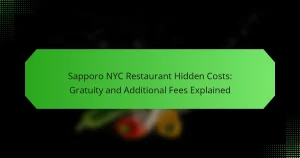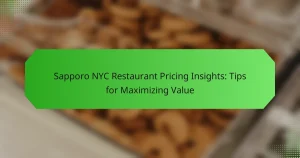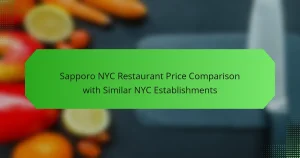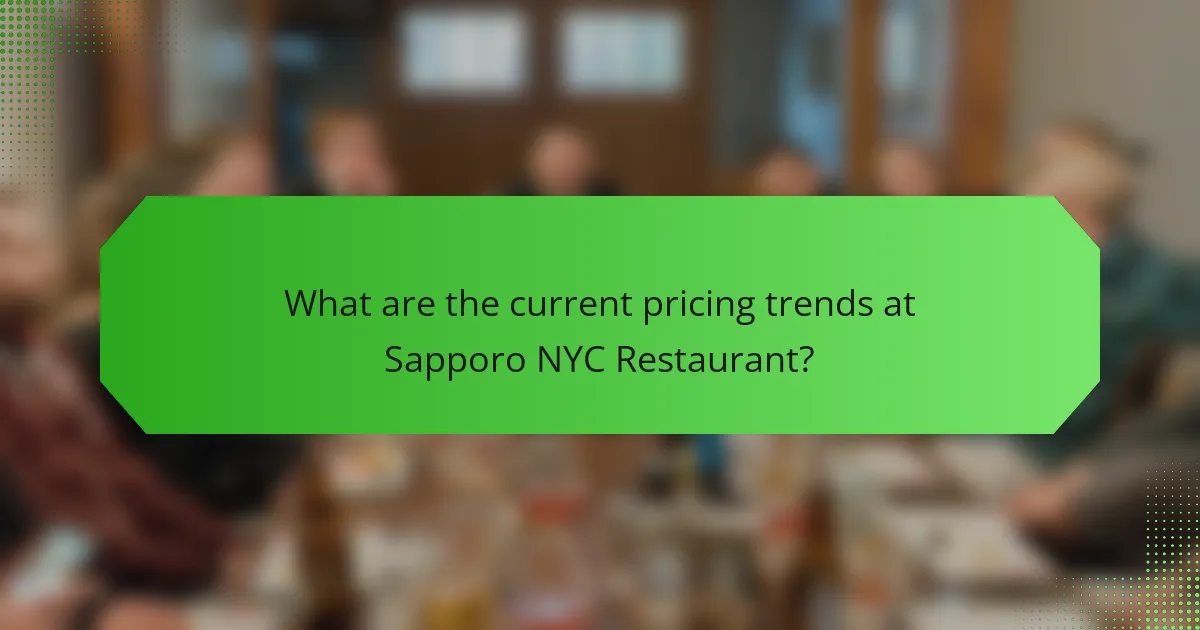
What are the current pricing trends at Sapporo NYC Restaurant?
Current pricing trends at Sapporo NYC Restaurant show a slight increase in menu prices. This adjustment reflects rising ingredient costs and inflationary pressures. Seasonal specials offer limited-time discounts, attracting customers during off-peak periods. Popular dishes have seen price adjustments, averaging 5-10% increases. Additionally, promotional events contribute to fluctuating prices. Data from local dining reviews indicate customer satisfaction despite the price changes. Overall, Sapporo NYC Restaurant adapts pricing based on market conditions and customer demand.
How do seasonal changes impact pricing at Sapporo NYC Restaurant?
Seasonal changes significantly impact pricing at Sapporo NYC Restaurant. The restaurant adjusts its menu prices based on the availability of seasonal ingredients. For instance, seafood prices fluctuate with supply, affecting overall costs. Additionally, during peak seasons, such as summer, demand increases, leading to higher prices. Conversely, in off-peak seasons, prices may decrease to attract more customers. Historical data shows that restaurants typically increase prices by 10-15% during busy months. This pricing strategy helps maintain profitability while managing customer expectations.
What specific seasons show the most significant price adjustments?
The specific seasons that show the most significant price adjustments in Sapporo NYC restaurants are winter and summer. During winter, demand for warm dishes increases, leading to higher prices. Conversely, summer sees a surge in outdoor dining, which can also drive prices up. Historical data indicates that winter prices rise by an average of 15% compared to other seasons. Summer price adjustments can vary but often reach up to 10% due to increased foot traffic. These seasonal trends reflect consumer behavior and ingredient availability.
How do customer preferences influence seasonal pricing strategies?
Customer preferences significantly influence seasonal pricing strategies in restaurants. During peak seasons, such as summer or holidays, customers often seek unique dining experiences. This demand allows restaurants to increase prices for seasonal dishes or special menus. Conversely, during off-peak times, customers may prefer discounts or promotions. Restaurants may lower prices to attract more patrons during these slower periods. Data shows that 70% of consumers are influenced by seasonal trends in their dining choices. By aligning pricing strategies with customer preferences, restaurants can optimize revenue and enhance customer satisfaction.
What special offers are available at Sapporo NYC Restaurant?
Sapporo NYC Restaurant currently offers a variety of special promotions. These include happy hour discounts on select drinks and appetizers. Additionally, they have seasonal menu items that are available at a reduced price. Special events may also feature unique pricing for group dining. For the most accurate and updated information, checking their official website or contacting the restaurant directly is recommended.
How do these special offers vary throughout the year?
Special offers at Sapporo NYC vary throughout the year based on seasonal trends and holidays. For instance, during summer, the restaurant may offer discounts on cold dishes and refreshing beverages. In contrast, winter months might feature promotions on hearty meals and warm drinks. Holiday seasons often include special menus or limited-time offers to attract customers. Additionally, events such as restaurant week can lead to unique pricing strategies. These variations are designed to align with customer preferences and seasonal ingredients.
What types of promotions are most popular among diners?
Discounts and happy hour promotions are the most popular types of promotions among diners. Research indicates that 55% of diners are attracted to discounts on food and beverages. Additionally, happy hour specials, which typically offer reduced prices on drinks and appetizers, draw significant crowds. Loyalty programs are also favored, with 65% of customers participating in such schemes for rewards. Seasonal promotions, like holiday-themed menus, engage diners looking for unique dining experiences. These promotional strategies effectively increase foot traffic and customer retention in restaurants.
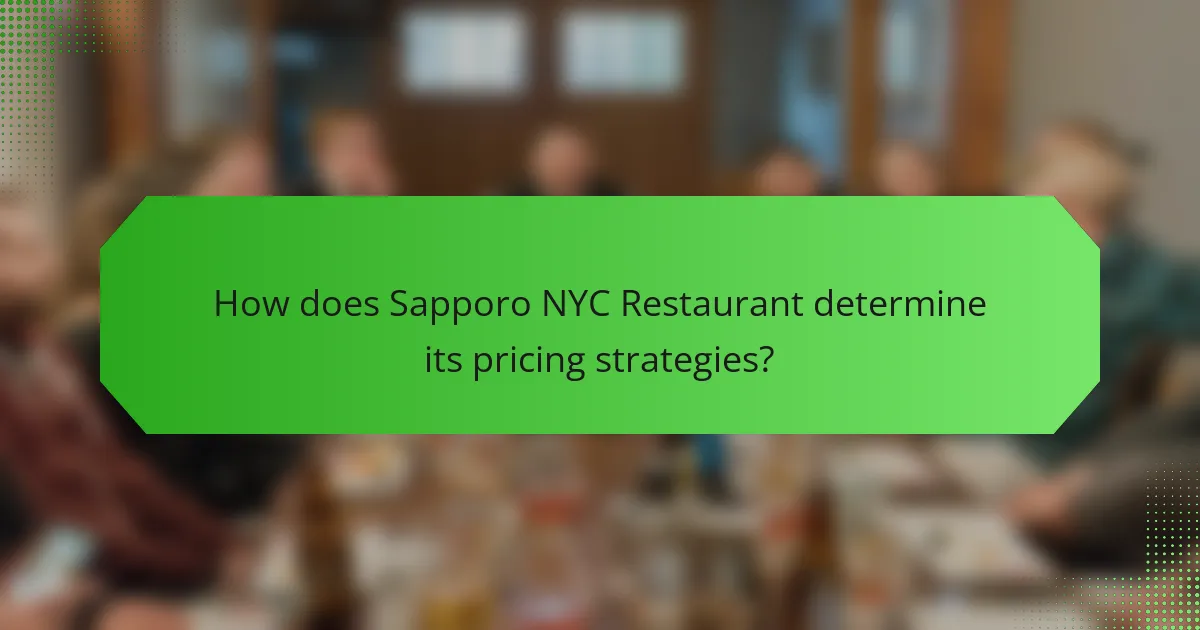
How does Sapporo NYC Restaurant determine its pricing strategies?
Sapporo NYC Restaurant determines its pricing strategies by analyzing market trends and customer demand. The restaurant assesses the competitive landscape to set prices that attract patrons while ensuring profitability. Seasonal ingredients and menu changes influence pricing adjustments throughout the year. Special offers and promotions are crafted based on customer preferences and dining patterns. The restaurant also considers operational costs, including labor and ingredient sourcing, to maintain a sustainable pricing model. Regular reviews of sales data help refine pricing strategies over time. This approach ensures that Sapporo NYC remains competitive and appealing to its target audience.
What factors contribute to the pricing decisions at Sapporo NYC Restaurant?
Pricing decisions at Sapporo NYC Restaurant are influenced by multiple factors. These include ingredient costs, labor expenses, and overhead costs. Seasonal availability of ingredients affects pricing strategies. High-demand periods may lead to increased prices. Competition within the local dining scene also plays a role. Customer preferences and feedback can impact menu pricing. Special offers and promotions are factored into overall pricing strategies. Economic conditions and inflation can influence pricing adjustments as well.
How do ingredient costs affect menu pricing?
Ingredient costs directly influence menu pricing by determining the base cost of each dish. Higher ingredient costs typically lead to increased menu prices to maintain profit margins. Restaurants analyze ingredient prices regularly to adjust their pricing strategies accordingly. For example, if the cost of seafood rises due to supply chain issues, restaurants may raise prices on related menu items. Conversely, lower ingredient costs can allow for competitive pricing or promotions. Studies show that menu prices often reflect ingredient market trends. According to the National Restaurant Association, 60% of restaurants adjust prices based on food cost fluctuations. This correlation ensures that restaurants remain profitable while offering quality dishes.
What role does competition play in setting prices?
Competition plays a crucial role in setting prices. It influences how businesses determine their pricing strategies. When multiple restaurants offer similar products, they often adjust prices to attract customers. This can lead to price wars, where establishments lower prices to gain market share. Conversely, if a restaurant differentiates itself through unique offerings, it may maintain higher prices. Market analysis shows that restaurants frequently monitor competitors’ pricing to remain competitive. According to a study by the National Restaurant Association, 70% of restaurant owners adjust prices based on competitor actions. Thus, competition directly impacts pricing decisions in the restaurant industry.
How does customer feedback influence pricing at Sapporo NYC Restaurant?
Customer feedback influences pricing at Sapporo NYC Restaurant by guiding menu adjustments and pricing strategies. The restaurant analyzes customer reviews and suggestions to identify popular dishes and pricing perceptions. Feedback on portion sizes and ingredient quality also impacts pricing decisions. For instance, if customers express dissatisfaction with price-to-value ratios, the restaurant may adjust prices or enhance offerings. Seasonal trends reflected in customer preferences can lead to temporary price changes for specific items. This responsive approach helps maintain customer satisfaction and loyalty. Overall, integrating customer feedback ensures pricing aligns with consumer expectations and market demand.
What methods are used to gather customer feedback on pricing?
Surveys are commonly used to gather customer feedback on pricing. Restaurants can distribute surveys through email or in-person after a dining experience. These surveys often include questions about perceived value and pricing satisfaction. Focus groups are another effective method. They allow for in-depth discussions about pricing strategies. Online reviews also provide valuable insights into customer perceptions of pricing. Social media polls can quickly gauge customer opinions on specific price points. Each method offers unique advantages in understanding customer sentiment regarding pricing.
How does Sapporo NYC Restaurant respond to customer pricing concerns?
Sapporo NYC Restaurant addresses customer pricing concerns by actively engaging with feedback. The restaurant encourages patrons to share their thoughts on pricing through surveys and direct communication. Management reviews this feedback regularly to identify trends and areas of concern. They adjust menu prices seasonally to reflect ingredient availability and market conditions. Special offers and promotions are often introduced to provide value during peak times. This approach ensures that customer perspectives are considered in pricing strategies. By maintaining transparency about pricing changes, Sapporo NYC fosters trust with its clientele.

What insights can be gained from analyzing Sapporo NYC Restaurant’s pricing trends?
Analyzing Sapporo NYC Restaurant’s pricing trends reveals patterns in customer demand and seasonal fluctuations. The restaurant adjusts prices based on peak dining seasons, such as holidays and summer. Special offers may be implemented during off-peak times to attract more customers. Historical data shows that price reductions lead to increased foot traffic. Additionally, tracking competitor pricing can inform Sapporo’s strategy. Understanding these trends helps optimize revenue and improve customer satisfaction. Overall, pricing analysis is crucial for strategic decision-making in the restaurant industry.
What patterns can be observed in Sapporo NYC Restaurant’s pricing over time?
Sapporo NYC Restaurant’s pricing has shown a consistent pattern of seasonal adjustments. Prices tend to increase during peak dining seasons, such as summer and holiday periods. Conversely, discounts are often offered during off-peak times to attract customers. Special promotions and limited-time offers have also been a recurring strategy to boost sales. Historical data indicates that menu prices may rise annually, reflecting inflation and increased ingredient costs. Customer feedback often influences pricing strategies, leading to adjustments based on demand. Overall, the pricing trends at Sapporo NYC Restaurant reflect a dynamic approach aimed at maximizing customer engagement and profitability.
How do economic factors influence pricing trends?
Economic factors significantly influence pricing trends by affecting supply and demand dynamics. When the economy is strong, consumer spending increases, leading to higher demand for restaurant services. This increased demand can drive prices up as restaurants capitalize on higher consumer willingness to pay. Conversely, during economic downturns, consumer spending typically decreases. This results in lower demand, prompting restaurants to lower prices to attract customers.
Inflation also plays a crucial role in pricing trends. As costs for ingredients and labor rise, restaurants often pass these costs onto consumers through higher menu prices. Additionally, changes in disposable income affect pricing strategies. Higher disposable income allows restaurants to set premium prices for their offerings.
Market competition influences pricing as well. In a saturated market, restaurants may lower prices to remain competitive. According to a study by the National Restaurant Association, 60% of restaurateurs adjust prices based on economic conditions. This illustrates how closely pricing strategies are tied to economic factors.
What lessons can other restaurants learn from Sapporo NYC Restaurant’s pricing strategies?
Sapporo NYC Restaurant’s pricing strategies offer valuable lessons for other restaurants. They implement seasonal pricing adjustments to align with ingredient availability and customer demand. This approach helps manage costs effectively while maximizing profit margins. Sapporo also utilizes special offers to attract customers during off-peak times. These promotions create a sense of urgency and encourage repeat visits. Moreover, transparent pricing enhances customer trust and satisfaction. By analyzing customer feedback, Sapporo refines its pricing strategies to better meet expectations. Other restaurants can adopt similar tactics to optimize their pricing and boost revenue.
What are the best practices for diners to take advantage of pricing trends at Sapporo NYC Restaurant?
Diners can take advantage of pricing trends at Sapporo NYC Restaurant by monitoring seasonal menus and special promotions. Seasonal menus often feature dishes at lower prices due to ingredient availability. Additionally, diners should subscribe to the restaurant’s newsletter for exclusive offers. Engaging with the restaurant on social media can also provide insights into flash sales or limited-time discounts. Dining during off-peak hours may result in reduced pricing or special deals. Utilizing loyalty programs can further enhance savings. Regularly checking the restaurant’s website for updates ensures diners are informed about pricing changes. These practices help diners maximize their dining experience while minimizing costs.
How can diners effectively utilize seasonal offers for better value?
Diners can effectively utilize seasonal offers by planning visits during promotional periods. Seasonal offers often include discounts or special menus that highlight fresh ingredients. Diners should research local restaurants to identify these promotions. Many restaurants announce seasonal offers on social media or their websites. This allows diners to compare deals across different establishments. Additionally, diners can take advantage of off-peak hours when discounts may be more significant. Utilizing loyalty programs can also enhance the value of seasonal offers. According to a survey by the National Restaurant Association, 70% of diners are attracted to seasonal promotions. This trend indicates that diners can benefit from strategic planning around these offers.
What tips can help diners maximize their dining experience at Sapporo NYC Restaurant?
To maximize the dining experience at Sapporo NYC Restaurant, diners should consider making reservations in advance. This ensures a table during peak hours. Diners should also explore the seasonal menu offerings. Seasonal dishes often highlight fresh ingredients. Ordering a variety of items for sharing can enhance the experience. This allows diners to sample multiple flavors and textures. Additionally, asking staff for recommendations can lead to discovering signature dishes. Pairing meals with suggested beverages can elevate the overall dining experience. Finally, providing feedback to the staff can contribute to personalized service on future visits.
Sapporo NYC Restaurant is the primary entity discussed in this article, focusing on its pricing trends influenced by seasonal adjustments and special offers. The article outlines how rising ingredient costs and inflation lead to slight menu price increases, while seasonal specials and promotions attract customers during off-peak periods. Key sections address the impact of seasonal changes on pricing, customer preferences, and the role of competition and feedback in shaping pricing strategies. Additionally, insights into popular promotions and best practices for diners to maximize value are provided, highlighting the dynamic nature of Sapporo NYC Restaurant’s pricing approach.
